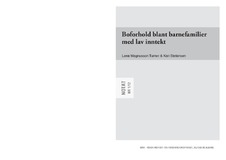Boforhold blant barnefamilier med lav inntekt
Notat

Åpne
Permanent lenke
https://hdl.handle.net/20.500.12199/3395Utgivelsesdato
2012Metadata
Vis full innførselSamlinger
- NIBR notat [1018]
Sammendrag
Part I of this working paper presents research on children in low income families and housing. The chapters 2–4 draw primarily on Norwegian research and address the following questions: What is the prevalence of low income among Norwegian families with children, and what are the main risk factors for low income? To what extent is low family income associated with low quality housing and neighbourhood problems? And how do children experience low quality housing? Chapter 5 and 6 give an overview of relevant international research. More specifically they focus on how housing and neighbourhood quality affect children’s life chances, and the mechanisms that explain the documented associations. The relevance of these findings for the Norwegian context is discussed. Issues for further research are also identified. In part II the living conditions among children in low-income families are explored. The study attaches particular significance to families with a combination of persistent low income and persistent poor housing. The study is based on a database at NOVA, covering children and young people living in low-income families during the period 2000 to 2009. The main questions in the current study can be phrased as follows: What are the characteristics of families with persistent poor housing, and which housing problems are these families faced with? An important intention is to provide useful information for the construction of targeted actions in the fields of housing policy and social policy. Similar to previous analyses this study shows that housing conditions have improved over time. Importantly, the risk of poverty has acquired an ethnic character. Among families permanently at risk of poverty, there are relatively more children with parents born abroad than in Norway, regardless of whether the children are born in Norway or not. The significance of housing conditions, poverty (‘at risk of poverty’) and low income are clearly brought out in the study. The database contains a few variables that can be related to children's living conditions. One variable is the disposition of an own room and a second is the ability to socialize with peers, measured by how often the child has friends at home. A straightforward statistical test indicates a stronger link between overcrowding and the disposition of an own room than between risk of poverty and the disposition of an own room. Special analyses have been made for families who live in rented accommodation for a longer period. These families are marked by, in accidental order, a frequent reception of social benefit; a persistent risk of poverty; a low housing quality; a high proportion of immigrants; and a high risk of overcrowding. Children who live in rented accommodation over a longer period tend to lack a separate room. This deficiency, however, appears to have a limited effect on practical behavior: they bring home friends to the same extend as other children. Families who live in rented accommodation for a longer period are often described as economically disadvantaged. Results from this study confirm this description. Adults in long-term rented accommodation have a much higher unemployment rate than others. It is, in fact, almost ten times higher. These families also have a lower probability to move from rented accommodation to owner occupation, i.e. to move upwards on the housing ladder. Put differently, a number of families remain stuck in a difficult position as unemployed tenants. A family situation marked by poverty, poor housing, overcrowding and/or housing insecurity can easily reduce children’s life chances. Previous research has identified effects of overcrowding, such as anxiety and increased morbidity. This study has only analysed the possibility for children to have an own room and bring home friends. Sharing room and not bringing friends home might have further repercussions, such as a lack of friends and a sense of being outside or even deviant. Rather than be a step towards owner occupation, the rented dwelling has become a permanent home. Despite a strong labour market, there are families in Norway with long term unemployed adults, who for varying length of time live on social assistance. For them is the policy defined temporary dwelling a more or less permanent one. Temaet for dette notatet er boforhold blant barn i lavinntektsfamilier. Boforhold omfatter både den konkrete boligen og nærmiljøets kvalitet. Notatet består av to deler. Del I tar utgangspunkt i foreliggende forskning og belyser blant annet hvilke sammenhenger det er mellom lav inntekt og boforhold, hvordan barn selv opplever dårlige boforhold og hvilken betydning dårlige boforhold har for barns livssjanser. Et tema som belyses særskilt er de mekanismer som er framsatt som forklaringer på disse sammenhengene. Del II er en empirisk undersøkelse der fokuset rettes spesielt mot familier med vedvarende lav inntekt og vedvarende dårlige boforhold, samt familier som leier boligen over lengre tid. Familier som over lang til har hatt lav boligkvalitet skiller seg fra andre familier ved at de oftere leier boligen, mottar sosialstønad, er enslige forsørgere, har innvandrerbakgrunn og bor trangt. Trangboddheten påvirker barna i form av lavere sannsynlighet for å ha eget rom, og større sannsynlighet for ikke å ha venner på besøk.